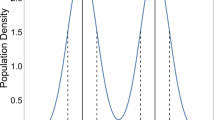Abstract
In this paper we describe a simple model of individual voting behavior and present its implications for the candidate positioning problem under both vote and plurality maximization. Under our assumptions, some voters at the extremes of the ideological spectrum typically will not vote because they are alienated by the equilibrium location of candidates. There will also be some voters in the middle of the ideological spectrum who will not vote because they are indifferent between the equilibrium locations of the candidates. Both the abstention from alienation and from indifference arise explicitly from utility maximization. Once we allow for alienation and indifference, the two alternative candidate objective functions (vote maximization and plurality maximization) yield different outcomes. In particular, we show that under vote maximization the Median Voter (or Minimum Differentiation) outcome will not arise. On the other hand, under plurality maximization, the Median Voter outcome may or may not hold, depending on the distribution of voter preferences.
Similar content being viewed by others
References
Aranson P, Hinich M, Ordeshook P (1974) Election goals and strategies: equivalent and nonequivalent candidate objectives. Am Polit Sci Rev 68:135–152
Downs A (1957) An economic theory of democracy. Harper & Row, New York
Enelow J, Hinich M (1984a) The spatial theory of voting. An introduction. Cambridge University Press, New York
Enelow J, Hinich M (1984b) Probabilistic voting and the importance of centrist ideologies in democratic elections. J Polit 46:459–478
Hinich M (1977) Equilibrium in spatial voting: the median voter result is an artifact. J Econ Theory 16:208–219
Hinich M, Ordeshook P (1969) Abstentions and equilibrium in the electoral process. Publ Choice 7:81–106
Hinich M, Ordeshook P (1970) Plurality maximization vs. vote maximization: a spatial analysis with variable participation. Am Polit Sci Rev 64:772–791
Hotelling H (1929) Stability in competition. Econ J 39:41–57
Ledyard J (1984) The pure theory of large two-candidate elections. Publ Choice 44:7–42
Palfrey T (1984) Spatial equilibrium with entry. Rev Econ Stud 51:139–156
Palfrey T, Rosenthal H (1985) Voter participation and strategic uncertainty. Am Polit Sci Rev 79:62–78
Prescott E, Visscher M (1977) Sequential location among firms with foresight. Bell J Econ Manage 8:378–393
Riker W, Ordeshook P (1973) An introduction to positive political theory. Englewood Cliffs, Prentice-Hall, New York
Smithies A (1941) Optimum location in spatial competition. J Polit Econ 49:423–439
Author information
Authors and Affiliations
Additional information
We should like to thank Jerry Fusselman, Jon Hamilton, Mel Hinich, Charlie Holt and participants at seminars at the University of Virginia, Northwestern University and the 1989 Meetings of the Public Choice Society and the Economic Science Association for their helpful comments.
Rights and permissions
About this article
Cite this article
Anderson, S.P., Glomm, G. Alienation, indifference and the choice of ideological position. Soc Choice Welfare 9, 17–31 (1992). https://doi.org/10.1007/BF00177667
Received:
Accepted:
Issue Date:
DOI: https://doi.org/10.1007/BF00177667




